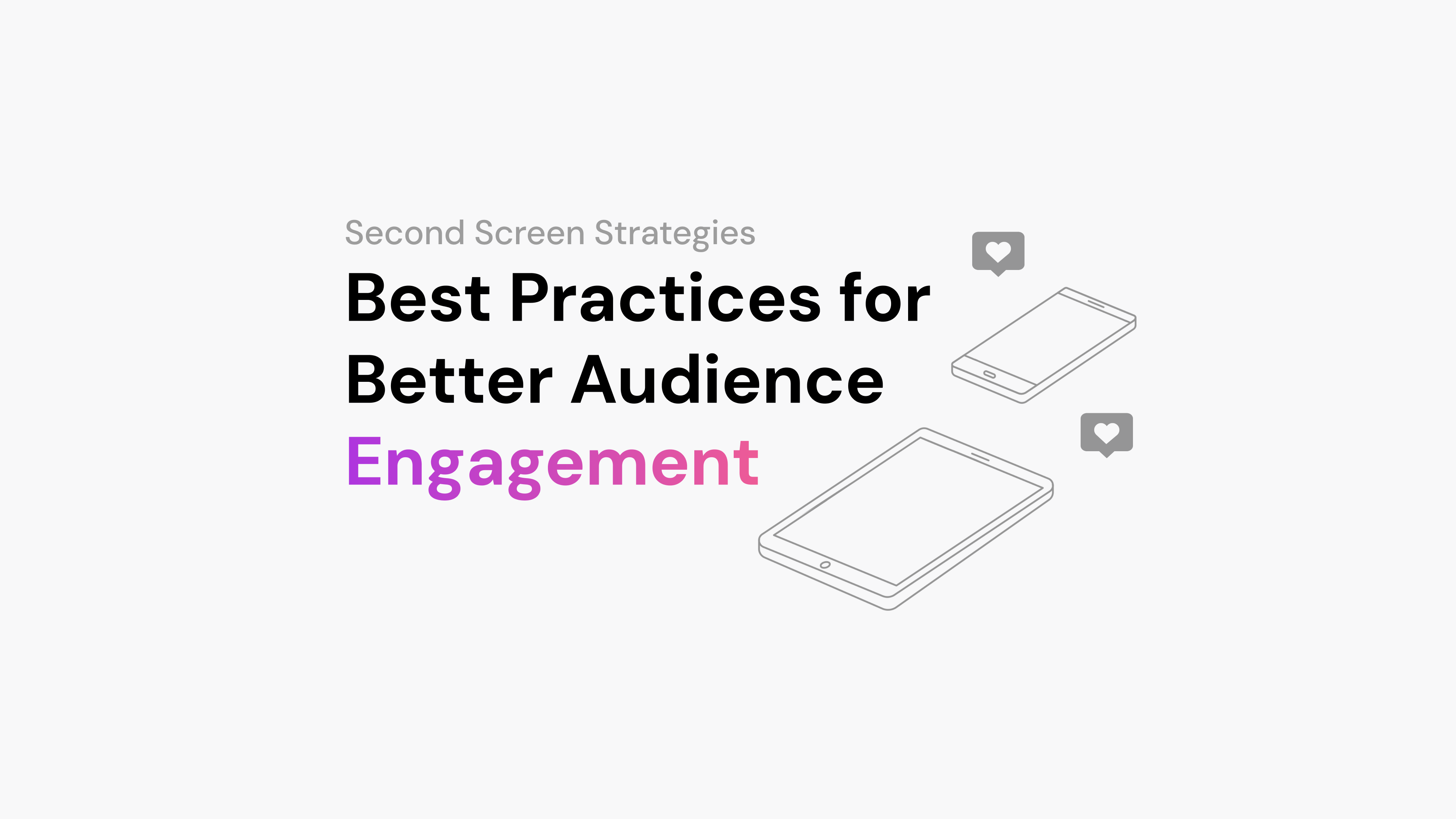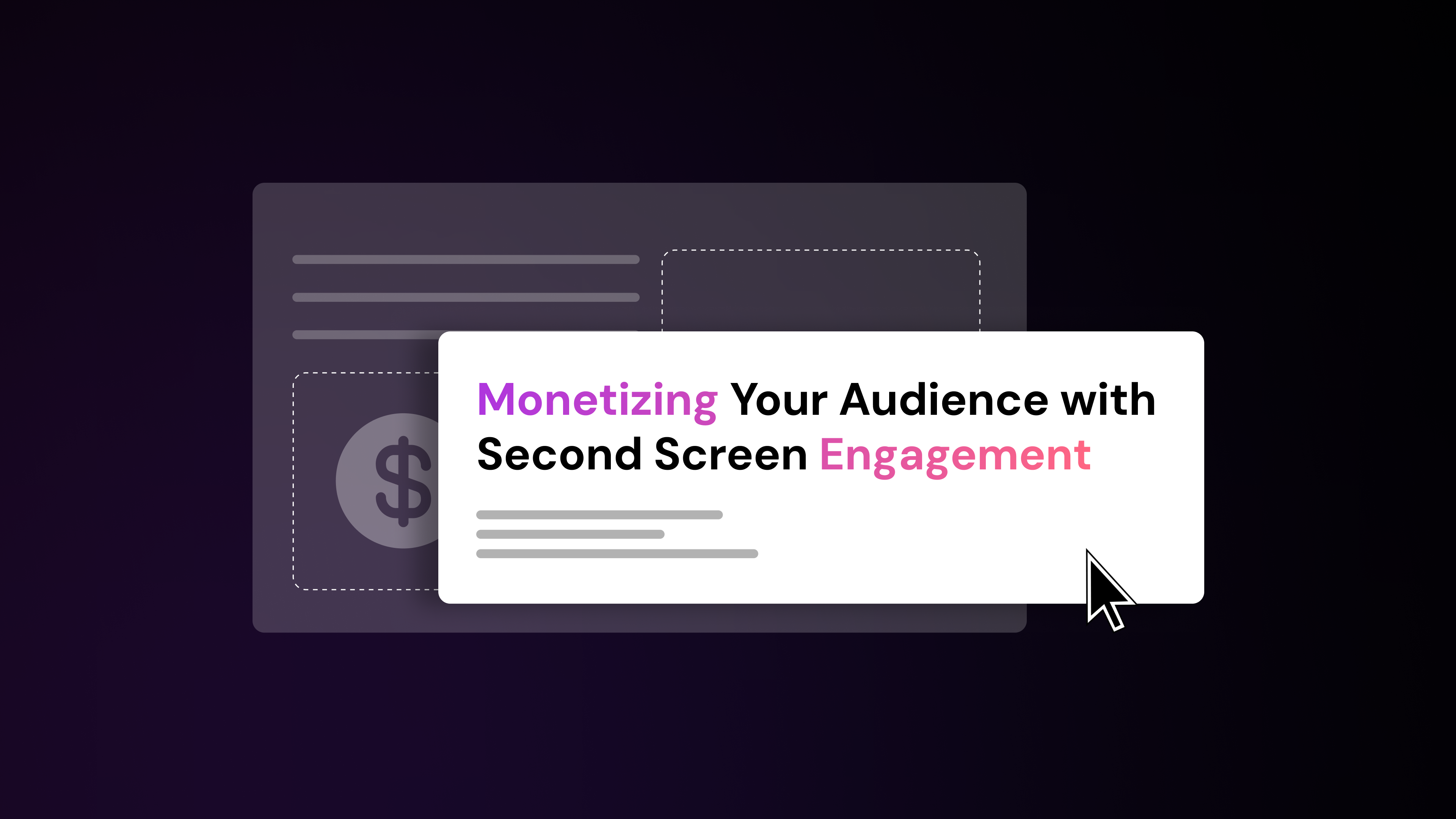Second screen technology is transforming the way we consume media, turning traditional TV viewing into a dynamic, interactive experience. As viewers increasingly use smartphones or tablets alongside their televisions, they add layers of social interaction, shopping opportunities, and personalized content to their entertainment. For content managers and digital marketing professionals, embracing these new media consumption patterns is key to enhancing audience engagement and creating interactive experiences.
In brief:
- Learn how the use of smartphones and tablets alongside TV is changing viewer engagement.
- Discover how interactive content and advertising strategies can captivate multitasking audiences.
- See how second screens enable personalized experiences and foster community among viewers.
- Find out how businesses can implement effective second screen strategies to boost engagement and drive growth.
What is Second Screen Usage?
Second screen usage involves using a secondary device like a smartphone, tablet, or laptop while watching TV. This behavior potentially influences how we watch television by introducing interactive elements and second-screen experiences that may enhance viewer engagement.
Social interaction is also a significant part of second screen usage. Around 41% of viewers participate in social media discussions or message friends about the content they are viewing. By sharing their experiences, viewers turn television into a communal activity.
Second screens also encourage commercial activities, with 35% of users shopping for products related to what they see on TV. This blend of media consumption and commerce creates new opportunities for marketers and advertisers.
Second screen usage is about engaging more deeply with content beyond the primary screen. As this trend grows, it will shape the future of media consumption.
Prevalence and Impact of Second Screen Usage on Media Consumption
Second screen usage has changed media consumption habits, with many viewers integrating digital devices into their TV watching experience. According to Ars Technica, 88% of Americans engage with a second screen while watching television. This trend is even higher among younger generations, with 94% of Gen Z and 95% of Millennials frequently multitasking with a second screen. Smartphones are the preferred device, used by 70% of second screen users.
Social media plays a significant role in this behavior, turning television into a social event with real-time interaction and discussion. Sports viewers are particularly active, with 32% using social media platforms while watching games.
Generational differences affect social media usage patterns. While Facebook remains the overall leader, Gen Z prefers platforms like Instagram, Snapchat, and TikTok. These trends influence content creation and marketing strategies. Content creators and advertisers need to understand these dynamics to engage effectively with modern audiences.
Changes in Media Consumption Patterns Due to Second Screen Behavior
Second screen usage has altered how we experience media. According to TechCrunch, 88% of Americans use a second screen while watching TV, which leads to divided attention as multitasking pulls focus away from the primary content.
Using a second screen often involves:
- Browsing the internet
- Engaging with social media
- Shopping online during TV viewing
While this can enhance engagement by allowing viewers to explore related information, it also results in a fragmented viewing experience. Statista reports that 68% of U.S. internet users access the internet via smartphone during TV viewing, suggesting many viewers are not fully focused on the primary screen. These second screen usage statistics highlight the challenge content creators face in keeping viewers engaged, as only 7% of viewers use their second screens for content related to what they are watching on the main screen.
This divided attention poses challenges for advertisers and content creators. Traditional advertising methods may lose effectiveness if viewers turn to their devices during commercial breaks. The constant switching between platforms can also lead to a less immersive experience, as noted by the Verisign Blog.
Content creators are exploring new ways to engage viewers, including the use of interactive elements and social media strategies to enhance the viewing experience across various platforms. Understanding and addressing these multitasking challenges is important for maintaining audience engagement and delivering effective content.
Enhanced Engagement and Interactivity through Second Screen Usage
Using a second screen while watching TV enriches the viewing experience and opens up new opportunities for content creators and advertisers.
Interactive Content and Advertising Opportunities
Second screen technology allows viewers to engage with content more deeply by accessing real-time statistics during sports events, following live blogs, and exploring character backgrounds in TV series. Social media integration allows for live discussions and viewer polls, transforming passive watching into an interactive experience.
For advertisers, these screens offer creative possibilities. Participating in interactive ad campaigns that synchronize with TV content captures attention and encourages immediate viewer interaction. These campaigns use second screen technology to create companion apps or platforms that enhance the viewing experience with additional content and interactive features like quizzes and polls. According to Digital Trends, advertisers are increasingly using interactive elements to create additional ad spaces and target audiences more precisely.
Data Collection and Personalization Benefits
Interactions with second screen content generate valuable data that can personalize the viewing experience while maintaining GDPR compliance. Arena.im has implemented measures to enhance anonymity and allows users to manage consent requests, ensuring responsible and legal data handling. This data helps content creators and advertisers understand viewer preferences and behavior, enabling them to craft tailored content and targeted advertising. Personalization enhances engagement by delivering content that aligns with individual interests, fostering a sense of loyalty and connection.
Using insights from Arena, brands can enhance their audience engagement strategies to better meet audience needs. Arena offers detailed strategies and tools for increasing engagement through social media, interactive elements, and feedback, along with analytics tools to monitor and adjust strategies based on data for improved outcomes. For more detailed strategies, refer to the Ultimate Guide to Audience Engagement by Arena. Viewers enjoy a more customized experience, and businesses can optimize their advertising efforts, making interactions more meaningful and effective. The synergy between engagement and data collection highlights the potential of second screens in the media landscape.
Social Viewing Experience Enabled by Second Screens
Second screen technology has transformed TV viewing into a social activity by enabling real-time interactions through social media integration on various platforms. This allows fans to engage in discussions, share content, and connect with others, enhancing the excitement of events and creating a unified experience for both at-home and in-person audiences. Live tweeting about a favorite show or engaging in discussions on Facebook fosters a sense of community among viewers. Notably, 72.6% of U.S. social media users engage in TV-related activities on Facebook, turning passive viewership into interactive dialogue.
Creating a Social Viewing Environment
Second screens enable viewers to engage and share thoughts during live TV events. Social media integration with platforms like X (formerly Twitter) and Instagram provides spaces for real-time commentary and discussion. For example, 32% of sports viewers use social media while watching, creating a more interactive viewing environment.
Impact on Sports Broadcasting and Fan Engagement
In sports, second screens have significantly enhanced fan engagement. Viewers can:
- Access real-time statistics
- View alternative camera angles
- Participate in fantasy sports leagues
These activities deepen their connection to the game by allowing fans to use a second screen, such as a smartphone or tablet, to access interactive content in real time. This includes live statistics, instant replays, and social media discussions, turning viewers into active participants. Interactive features like polls, quizzes, and prediction games further enhance the fan experience and foster a sense of community. This level of interaction enriches the spectator experience and cultivates a more engaged fan base. Sports broadcasters can offer an immersive experience that keeps fans interested long after the final whistle.
Opportunities and Challenges for Content Creators and Advertisers
Second screen usage presents both challenges and opportunities for advertisers and content creators. With a majority of viewers—88% of Americans—engaging with a secondary device while watching TV, the media landscape is changing rapidly.
Using Second Screens in Advertising Strategies
For advertisers, second screen usage can create opportunities to engage audiences through website ad integrations. Synchronized ad campaigns that integrate e-commerce ads across TV and mobile devices can potentially boost engagement. Real-time marketing allows advertisers to respond to live events and trending topics instantly. However, capturing the attention of viewers who are often distracted by multiple screens is a challenge. Advertisers must create compelling content that draws attention and encourages interaction across platforms. Understanding ad integration ROI can be beneficial.
Creating Immersive Experiences for Content Consumption
For content creators, the second screen trend offers a chance to develop more immersive experiences. By creating companion content that complements the primary viewing experience, they can foster deeper engagement. This might include interactive apps, exclusive behind-the-scenes content, or engaging social media interactions. Leveraging data collected from second screen activities enables personalized content recommendations, enhancing viewer satisfaction and loyalty. Balancing content quality across both primary and secondary screens remains a challenge. The focus should remain on crafting narratives that captivate audiences, regardless of the device they use.
Personalized and Enhanced Content Experiences through Second Screens
Personalization is central to the second screen shift, offering a tailored media consumption experience that transforms passive viewing into an interactive journey. Second screens allow viewers to customize content based on their interests, significantly enhancing engagement. Research shows that 45% of U.S. adults frequently use a second screen while watching TV, highlighting the demand for more personalized viewing experiences.
This personalized approach not only increases engagement but also boosts viewer satisfaction. As viewers delve deeper into content that resonates with their preferences, they form stronger connections with the material. Data collected from second screen interactions can provide insights into viewer preferences, which may help content creators tailor their offerings more effectively and potentially enhance e-commerce experiences.
Such deepened engagement through personalized content fosters a stronger sense of loyalty among viewers. As they find more value in their media experiences, they are more likely to return, creating a cycle of engagement and loyalty. This shift is important for content managers and digital marketers aiming to build and sustain active, loyal audiences in today’s media landscape.
How to Use Second Screens for Business Growth
Second screen usage, utilizing second screen technology, offers businesses opportunities to enhance engagement and potentially drive growth. By integrating strategic approaches, companies can turn this trend into an advantage.
Implement Effective Second Screen Strategies
To use second screens effectively, focus on creating companion content that complements primary viewing experiences. This might include apps providing real-time statistics during sports events or behind-the-scenes content for TV shows, enhancing viewer engagement. Social interaction is another key element; integrating platforms like X (formerly Twitter) allows for real-time discussions, polls, and contests, creating a dynamic, interactive environment. Ensuring that experiences are mobile-optimized is crucial, as smartphones are the dominant second screen device. Consider cross-channel experiences by synchronizing content and ads across TV and mobile devices to reinforce messaging and encourage immediate engagement.
Learn from Successful Second Screen Implementations
Several companies have successfully harnessed the power of second screens to boost their growth. A notable strategy involves targeted advertising, where 65% of second screen users explore products seen on TV, and 20% make purchases during breaks. This approach allows brands to capture attention in real time and convert interest into sales. The “virtual watercooler” effect, where viewers engage in social discussions about shows, has proven to increase viewer loyalty and extend content lifecycles.
By embracing these strategies, businesses can capture the attention of their audience and create engaging, interactive experiences that foster customer loyalty and drive growth.
Embracing the Second Screen Revolution
Second screen usage is transforming media consumption, offering challenges and new opportunities for engagement. Content creators and advertisers who tap into this trend can craft immersive experiences that captivate and retain audiences. Ready to see how an effective brand community can impact your bottom line?
Sign up now at Arena and start using our features to enhance engagement and retention. Join the many brands that trust Arena to convert visitors into loyal customers.



